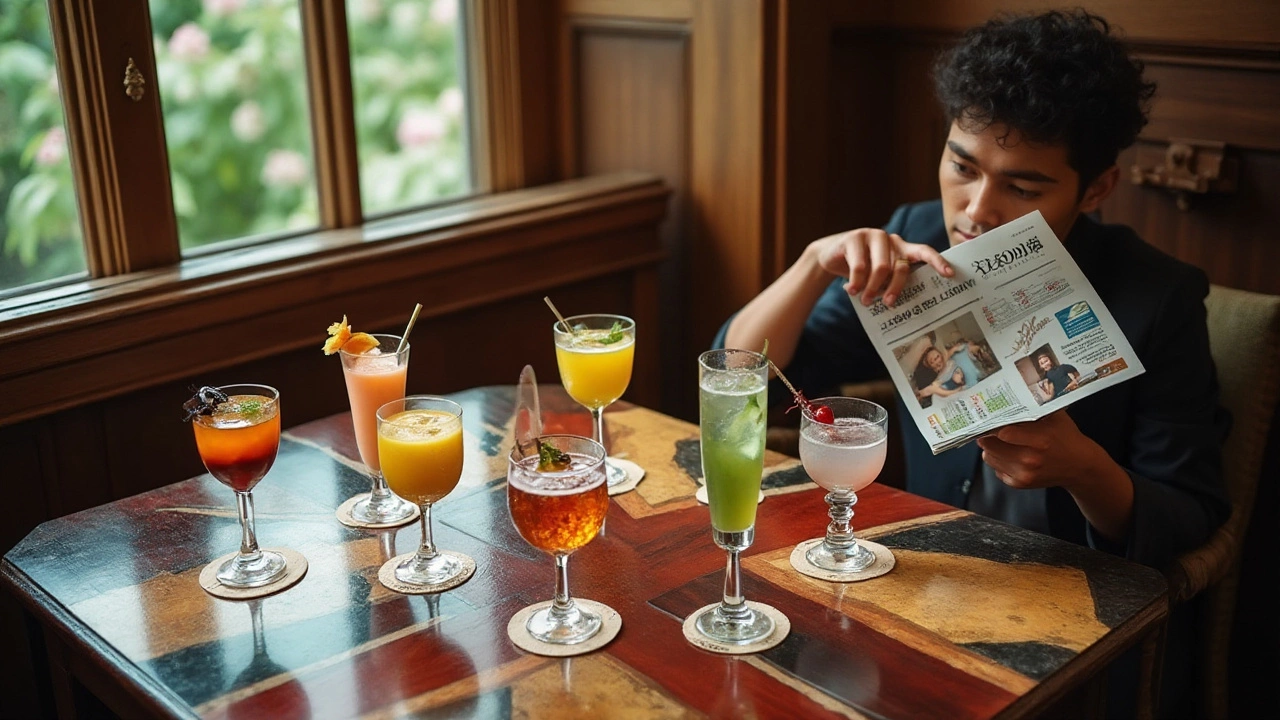When it comes to gaining weight from alcohol, knowledge is power. Some drinks are far more likely to expand your waistline than others, and it helps to know exactly what's in your glass. While many enjoy the refined taste of whisky, the question of its impact on weight can't be ignored in today's health-conscious world.
Alcoholish drinks bring more to the table than just good times; they are often loaded with calories. For whisky enthusiasts and social drinkers alike, learning about the caloric impact of different drinks can be both eye-opening and essential. So let's pour ourselves a glass of humble awareness and explore which alcoholic drinks are most likely to pile on the pounds and how to enjoy a tipple without tipping the scales.
- Alcohol and Caloric Content
- Whisky: A Deeper Dive
- Comparing Alcohol Types
- The Role of Mixers
- Tips for Mindful Drinking
- Balancing Social Life and Weight
Alcohol and Caloric Content
Understanding the caloric content of alcohol is key to making informed decisions about what to drink. Alcohol itself has a caloric value of about seven calories per gram, which places it higher on the calorie scale than proteins and carbohydrates. But what most people don't realize is how quickly those calories can add up, especially when indulging in drinks like whisky, which not only brings its comforting flavor but also a hefty dose of calories.
When it comes to whisky, a standard shot, which is roughly 1.5 ounces, carries about 105 calories. Now, this might not sound like much on its own, but consider a night out or even a quiet evening at home where you're likely having more than just one. The numbers multiply swiftly. It's critical to keep this in mind if you're watching your weight, particularly since these calories are often referred to as 'empty'—meaning they don't come with the beneficial nutrients that you'd find in a meal.
Some people might assume that lighter-colored spirits are lower in calories than darker ones like whisky. While they might offer fewer congeners—which are compounds linked to hangovers—they don't necessarily mean fewer calories. In fact, any alcohol, regardless of its color or flavor complexity, will deliver similar caloric content if consumed in equal quantities. This holds especially true when these drinks are consumed neat, without mixers.
It's not just whisky that's calorically dense; most alcoholic beverages can rapidly become calorie bombs. For example, a light beer has about 100 calories, whereas a pint of craft beer can easily hit the 200-calorie mark or even higher. Cocktails introduce another layer of complexity. Depending on the recipe, a cocktail can bring calories into the 400 range or more, especially when they're loaded with sugary mixers and garnishes. One of the key contributors to weight gain from alcohol is this often-overlooked calorie creep.
Yet, there's good news for those who want to maintain their social lifestyles while watching their waistlines. Being mindful of what you mix with your drinks can make a significant difference. Opting for beverages like seltzer water, diet sodas, or even just neat, on-the-rocks presentations can keep calorie counts in check. Experts in nutrition often suggest having a glass of water between alcoholic drinks to not only stay hydrated but also help limit overall calorie intake.
In the grand spectrum of dietary considerations, understanding the caloric content of beverages is vital. For those who enjoy their whisky and wish to partake in its enjoyment responsibly, being aware of its impact on daily caloric intake is invaluable. Moreover, by gaining insight into the content of these drinks, one can savor them without guilt, enjoying the flavors and social moments they bring while keeping health goals in sight.
Whisky: A Deeper Dive
When it comes to the rich flavors of whisky, enthusiasts know there's more beneath the amber glow than meets the eye. This beloved spirit isn't just a simple concoction of grain, water, and yeast; it’s a centuries-old tradition that captivates the senses. From single malts to blends, whiskies are adored for their complex profiles and diverse origins, each with unique stories to tell. The journey of whisky starts in verdant fields where grains like barley, corn, and rye are harvested. Each type imparts its distinct character, contributing to whisky’s myriad forms. The aging process in wooden barrels further influences flavor, deepening the color and developing those rich, smoky or sweet notes enthusiasts love so dearly.
Whisky is renowned for packing more than just history and flavor; it carries noteworthy calorie content too. With approximately 64 calories per 1-ounce serving, it can add up quickly for those who enjoy a glass or two. Unlike beer or wine, whisky doesn’t typically come with sugar-laden mixers, yet it's still a caloric contender. Sipping neat or on the rocks may seem benign, but these calories can accumulate surprisingly fast, especially if you're enjoying several rounds. An intriguing part of whisky consumption is often the occasion or ambiance, where the allure of warmth, camaraderie, and tradition enhances its appeal and, unconsciously, the consumption of more than intended.
"Whisky is liquid sunshine," said George Bernard Shaw, capturing the spirit’s allure. Though poetic, it's worth noting that excess sunlight can have its drawbacks, especially for those vigilant about their waistline.
Understanding calories in alcohol matters for those keeping an eye on weight gain. It's not just about reducing intake but being mindful of all factors: meal pairings, frequency of consumption, and overall lifestyle. Whisky enthusiasts might consider integrating more movement into their daily routines to counterbalance the indulgence or even explore low-calorie whisky alternatives. The art and science of whisky tasting encourage moderation, allowing savoring of nuanced flavors without going overboard on quantity – the perfect balance for a delightful yet responsible experience. This understanding is crucial, not just for managing weight but also for enjoying whisky to its fullest potential, tasting every subtlety it has to offer.

Comparing Alcohol Types
Embarking on an exploration of different alcohol types and their impact on weight requires a careful consideration of their caloric compositions. Each drink tells its own story, from the malty depths of beer to the smooth complexity of whisky. These beverages not only offer unique tastes but also varying caloric content that can impact your stumble on the scales. Beer, for instance, is often the culprit when it comes to packing on pounds due to its combination of carbonation, malt, and sugars. A typical pint carries anywhere from 150 to 200 calories. In social gatherings, where pints flow as freely as conversation, those calories can add up faster than one might think, leaving drinkers with a need for larger pants rather than larger cups.
On the other hand, whisky, cherished for its richness and complexity, generally contains around 105 calories per 1.5-ounce serving. Pure and unadulterated, most whiskies have a natural edge in the weight gain battle over mixed drinks and sugary offerings. However, the situation changes when you consider whisky-based cocktails, which introduce mixers and other ingredients that can ramp up the calorie count significantly. Opting for neat whisky might be a wiser choice for those counting calories, provided you savor it in moderation. This choice highlights the weight management aspect while still indulging in the craftmanship that goes into every bottle.
Wine lovers also find themselves at an interesting crossroads. While generally lower in calories than beer, wine still poses a caloric burden with about 120 calories per 5-ounce glass of white or around 125 for red. It's not just about the numbers; the sweet joy of a robust red or a crisp white sometimes melts away any concern over calorie intake. Yet, like whisky, the effect is heavily contingent on consumption habits. It's the leisurely refilling amidst dinner parties that can turn a simple pleasure into a cause for concern. A mindset towards alternating between wine and water during social gatherings can do wonders for the waistline.
"Wine is sunlight, held together by water," noted Galileo Galilei, reminding us that while wine is a beautiful creation, it's wise to consume it with care.
For those partial to cocktails, the vast array of flavors often comes at a caloric premium. Mixed drinks are notorious for sneaking in high-calorie sugar syrups, cream liqueurs, and sugary sodas, driving their calorie count above 300 per serving in some cases. It's a cocktail of indulgence and surprise that one must navigate with caution. Spirits like vodka or rum mixed with a splash of soda or tonic can make a refreshing alternative that keeps the calorie intake from spiraling.
A thorough understanding of the calories in alcohol is important for both health-conscious individuals and those looking to partake responsibly. A balanced approach, choosing spirits wisely and being mindful of mixers, can allow one to enjoy social occasions without undue worry about weight gain. In an era where awareness of health and fitness runs high, such knowledge provides a richer narrative than just the taste itself.
The Role of Mixers
Mixers can be the unsung heroes or hidden villains in the world of alcohol weight gain. It's amazing how much their presence affects the caloric content of your drink. A neat whisky might seem innocent enough, but when you add that sugary cola or a splash of tonic, things can change dramatically. Many don't consider the calories mixers can add to their favorite drinks, which is why it's so important to shed some light on this topic.
The basic mixer choices often include sodas, juices, and even energy drinks, each bringing its own calorie footprint. For instance, a typical can of cola can add around 150 calories to your drink. This might not seem like much until you consider multiple drinks over an evening. It's not just soda; fruit juices, often seen as a healthier option, can also pack a caloric punch. A mixer made from cranberry juice can add as much or even more sugar than a fizzy drink, leading to significant weight concerns over time.
Traditions can influence mixer choices as well. In some cultures, a shot of whisky is commonly followed by a carbonated mixer to cut through the strong alcohol taste. Although this practice makes the drink more palatable to newcomers, the additional sugars can lead to weight management problems. Additionally, tonic water is another common choice due to its slightly bitter taste that pairs well with spirits; however, not everyone realizes that it can contain as much sugar as soda.
In this light, awareness and choice of mixers can be a game-changer for someone trying to manage their calorie intake. There are, however, alternatives that can keep your drink refreshing without the added sugars. Whisky calories can be better managed by opting for zero-calorie sodas, sparkling water, or even infusing drinks with naturally flavored herbs or fruits. This way, the social aspect of drinking stays intact without the heavy caloric price tag, making it easier to strike a balance between indulgence and health.
"Choosing your mixers wisely can mean the difference between enjoying your drink and inadvertently contributing to weight gain," says nutrition expert Sarah Collins.That's a thought worth considering when you're deciding between mixers because each small substitution can bring you one step closer to maintaining a healthier lifestyle. Understanding the caloric content of both your alcohol and mixers can empower you to make informed, healthier choices that still allow you to enjoy the social pleasures of drinking.

Tips for Mindful Drinking
Engaging in mindful drinking can transform not just the way you enjoy your whisky but also how your body handles it. Whisky tasting, often steeped in tradition, can easily become an overwhelming indulgence if one does not tread carefully. The first tip for enjoying alcohol without unintended weight gain is to savor your drink. Taking smaller sips and truly appreciating the flavors can encourage slower drinking, giving your body more time to process the beverage. This practice may also reduce the likelihood of consuming too many calories in a single sitting. Consider how many times we've found ourselves refilling our glasses without thinking. Appreciating each sip can reduce the inclination to guzzle down an entire bottle.
Another effective approach to mindful drinking includes keeping track of what you're actually consuming. Many people underestimate the caloric content of their favorite alcoholic beverages. A standard whisky pour might surprise you with how many calories it actually contains, translating into unexpected weight gain if you're not keeping track. Apps and even simple notes on a smartphone can serve as gentle reminders of what you have consumed over a night, or, indeed, a week. Preparing ahead is another aspect of mindful drinking. If you know you'll be enjoying a drink or two, adjusting your meal portions throughout the day or the day before could account for those extra calories, helping maintain a healthier balance.
Water should always be your drinking companion, especially when relishing your favorite spirits. Alternating between alcohol and water can do wonders not only for your hydration but also in slowing down your intake of alcohol itself. This little trick can help those inclined to binge drink by providing a natural pause, giving your liver some space to catch up. It can also keep hangovers at bay, which are often exacerbated by dehydration. Dinis, a whisky expert I once met, advised:
"The art of drinking doesn't lie in drinking more, but in drinking smarter. A hydrated drinker is a happy one."Having a plan is also part of mindful consumption. Setting a limit before you start drinking can set clear boundaries that you can stick to, preventing that all-too-common slip from one drink to several more than planned.
Emphasizing less on mixers is a crucial practice in managing alcohol and related calorie intake. Many mixers, often shrouded in sweetness, are packed with sugar and can seriously ramp up the calories. Opting for a soda water instead of a sugary tonic or cola can drastically cut down calorie consumption. For those who favor more complex flavors, a twist of lemon or a splash of unsweetened juice can give your classic whisky drink a new edge, while keeping calories at bay. Engaging in alcohol-free days during the week can also contribute positively. It gives your body a chance to recuperate, and can serve as a reset button not just for your liver, but for your appreciation of the drink itself when you return to it.
Balancing Social Life and Weight
Navigating social activities while managing weight can feel like walking a tightrope, but it's definitely achievable with a little awareness and smart strategies. For many, social gatherings and celebrations often revolve around eating and drinking, possibly pushing calorie intake to unintended limits. Start by understanding your personal thresholds and identifying the scenarios where you are most likely to indulge excessively. Just knowing when you're prone to go overboard can prepare you for making more conscious choices. Be it a family barbecue or a night out with friends, having a plan can reduce the chances of an alcohol-induced calorie overload.
One efficient strategy is to set limits that align with your health goals before heading out. It's not as rigid as it sounds if you think of it more like guiding yourself to healthier habits. Theresa Romano, a nutrition expert, once shared her mantra: "Be selective but not restrictive—the key is to choose your indulgences wisely." Her advice emphasizes moderation rather than abstinence, which can often lead to binge episodes. Focus on alternatives like choosing whisky on the rocks instead of a calorie-heavy, sugary cocktail or a pint of beer, which could save you hundreds of calories without sacrificing the social experience.
Mindful drinking is another vital tactic. This isn't just about slowing down your drink intake, although savoring each sip of your chosen whisky can heighten the taste experience and reduce the number of refills. It's more about being present in the moment and enjoying the company, the conversation, and the atmosphere. Engaging with others takes the focus off your glass and distributes your evening's pleasures across a broader spectrum. Remember, alcohol sometimes acts as an emotional lubricant at social events, and balancing that with mindful consumption can significantly impact your waistline for the better.
Having non-alcoholic options on hand is always wise, giving you the freedom to pace yourself without feeling left out. Hydration is paramount, and alternating between alcoholic drinks and water can maintain hydration levels and slow down alcohol consumption, hence cutting down caloric intake. Staying hydrated also curbs the relentless next-day hangover cravings for greasy, calorie-dense foods which can negate all your weight management efforts.
For those interested in data, here's a reference point that might help inform your choices. According to a report by the National Institute on Alcohol Abuse and Alcoholism, drinking alcohol could increase weekly caloric intake by 384 calories on average per day. Being mindful and setting limits can reduce this significantly and aid your weight management journey.
Social drinking doesn’t have to derail your weight goals if approached with a mindful mindset. Choose wisely, engage deeply, hydrate adequately, and you'll find that maintaining your social life while managing your weight isn't just a balancing act, but a fulfilling one.


